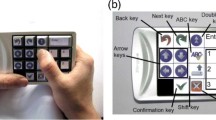Abstract
Integration of handicapped children in a normal school environment is a worldwide trend, but it creates major problems for the teaching institution because, obviously, the standard approach, tailored for a ‘normal’ population of pupils cannot work when the population is extended to include multiple categories of particular needs. Another worldwide trend is the increasing spread of technical aids, especially as advanced electronic devices. However, both phenomena appear to develop according to rather scattered and uncoordinated patterns: too many times, working with people who are involved in the rehabilitation area one happens to get the feeling that ‘integration’ and ‘technology’ are regarded as magic words, which somehow are thought to exercise the unsolved problems of handicapped population. In the context of the paper, we do not intend to face these problems in their full generality; however, as a bioengineering unit we have made the effort to take these problems into account while out-lining our design philosophy and our style of interaction with the cooperating rehabilitation institution.
Sommaire
Réintégrer les enfants handicapés à une vie scolaire normale est une technique répandue dans le monde entier; mais cela crée des problèmes importants d'éducation, parce que, bien sûr, l'approche courante, étudiée pour une population ‘normale’ d'élèves, ne peut fonctionner lorsque cette population se voit accrue de nombreuses catégories aux besoins particuliers. Une autre technique également répandue est celle du développement croissant d'appareils techniques de secours, en particulier de dispositifs électroniques avancés (Dalrympleet al. (1974), Lywoodet al. (1974), Tolsrup (1976), Vanderheideret al. (1973)). Toutefois, ces deux phénomènes semblent se développer de façon plutôt décousue et dispersée: trop souvent, en travaillant avec des personnes occupées à la réadaptation, on a l'impression que ‘intégration’ et ‘technologie’ sont considérés comme des mots magiques, qui auraient le pouvoir d'exorciser les problèmes non résolus des personnes handicapées. Notre propos n'est pas d'attaquer ces problèmes dans leur généralité tout entière; toutefois, en tant que biotechniciens, nous avons voulu en tenir compte, tout en soulignant notre philosophie d'étude et notre action réciproque avec l'institution, concourant à la réadaptation.
Zusammenfassung
Die Integration behinderter Kinder in eine normale Schulumgebung ist ein weltweiter Trend. Hierdurch werden jedoch für die Lehrinstitutionen große Probleme geschaften, da natürlicherweise, die auf den ‘normalen’ Schülerzuwachs zugeschnittene Norm nicht ausreicht, wenn der Zuwachs durch den Zugang verschiedener Kategorien mit besonderen Bedürfnissen erweitert wird. Ein anderer, weltweiter Trend ist die weitverbreitete Zunahme technischer Hilfsmittel, besonders der hochstehenden elektronsichen Geräte. (Dalrympleet al. (1974), Lywoodet al. (1974), Tolsrup (1976), Vanderheideret al. (1973)). Jedoch scheinen beide Phenomene sich nach ziemlich verstreuten und unkoordinierten Mustern zu entwickeln: wenn man mit Menschen zusammenarbeitet, die sich mit dem Rehabilitationsbereich befassen, dann geschieht es nur zu oft, daß man das Gefühl hat, daß ‘Integration’ und ‘Technologie’ als Zauberworte angesehen werden, denen man es irgendwie zuschreibt, daß sie die ungelösten Probleme der behinderten Bevölkerung exorzieren können. Der Sinn dieses Papiers ist es nicht, diese Probleme, in ihrer ganzen Allgemeinheit aufzugreifen; jedoch haben wir uns als eine biotechnische Einheit die Mühe gemacht, bei der Darstellung unserer Entwurfsphilosophie und unseres Interaktionsstils bei der ko-operierenden Rehabilitationsinstitution, diese Probleme zu berücksichtigen.
Similar content being viewed by others
References
Dalrymple, G. F., Bullock, A. andDanca, J. M. (1974) The auto-com at Kennedy Memorial Hospital. Proceedings of the 1974 Conference on Engineering Devices in Rehabilitation, Boston (Mass.), New England Medical Centre Hospital.
Lywood, D. W. andVasa, J. J. (1974) Computer terminal operating and communication aid for the severely handicapped.Med. & Biol. Eng.,12, 693–697.
Manfrino, R. (1960). L'entropia della lingua italiana e il suo calcolo.Alta Frequenza 29, 4–29.
Sandini, G. andZaccaria, R. (1975) Minicomputer as emulator of microcomputers: a general debugging software for microprocessors. TM008-75, IEUG-SSI, Istituto di Elettrotecnica, Genova.
Shannon, C. E. (1948) A mathematical theory of communication.Bell Syst. Techn. J.,27, 379–423.
Tolsrup, M. (1976) The Vidialog Display System for teaching and rehabilitation of the motor handicapped. Proceedings of the 13th World Congress of Rehabilitation International, Tel Aviv.
Vanderheider, G. C., Lamers, D. F., Volk, A. M. andGeisler, C. D. (1973) A new means of communication for the severely handicapped: the automonitoring communication board. Proceedings of the 4th Annual Meeting, Biomedical Engineering Society, Los Angeles.
Author information
Authors and Affiliations
Rights and permissions
About this article
Cite this article
Morasso, P., Sandini, G., Suetta, G. et al. LOGOS: a microprocessor-based device as a writing aid for the motor handicapped. Med. Biol. Eng. Comput. 16, 309–315 (1978). https://doi.org/10.1007/BF02442433
Received:
Accepted:
Issue Date:
DOI: https://doi.org/10.1007/BF02442433




